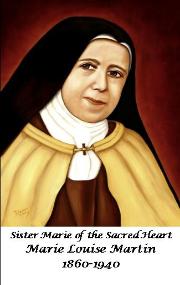Marie held many positions in the monastery such as assistant infirmarian, gardener, refectorian and the office of bursar (procurator) from 1894 to 1933. Marie’s task also was to initiate new postulants in the ways of Carmel. (CL) Even though Marie was united with her blood sisters in the Carmelite Monastery, there was very little time for them to interact with each other while taking care of the needs of other sisters. Marie taught her youngest sister when she first entered the Carmelite customs and her sister remarked to her: “When I meet you, you seem to me an angel…You, who are an EAGLE called to fly in the upper air and gaze upon the sun, pray for the little weak reed in the depths of the valley, the least puff of wind bends it over.” (CL) In 1915, Marie wrote to her younger sister Léonie in Caen: “I suppose that in heaven when we think of our earthly life, it will appear to us as a dream, a night passed in a bad Inn. Yes, truly our life here below is just that, and I feel, as you do, full of courage to climb the mountain of perfection, for I know well that it is Jesus who will carry me up in His arms, if I place in Him all my trust.” (GV) Marie suffered from rheumatoid arthritis and on April 29, 1923, her arthritis attacked her muscles and severely constricted her ability to function normally. Her affliction gradually grew worse as the years went on and she was finally confined to bed in the infirmary or moved about in a wheelchair. Her inability to move on her own was the worst penance for her for she was very generous and independent. (C) She suffered from rheumatoid arthritis for twenty-six years. In the latter part of 1924, Marie suffered severely from pneumonia causing her sisters to think she might die. Marie knew she was not going to die but expected her life to be more difficult in the coming years. On January 25, 1929, she was moved from her cell into the infirmary. Her legs and feet became consistently swollen and she was riddled with sores for eleven years. (M) In her last years, Marie allowed many different opinions to be expressed in front of her during recreation, without making any verbal judgments for or against that person’s perception, she maintained her Oblation of Love even through the most difficult times. (C) When the suffering became too much for her to handle, she would say: “Prayer is the state of my soul. I cry to the good God day and night; My God, come to my aid! Hasten! Hasten to help me!” And to persuade him the more, I add, “Thou Who art my tender Spouse, have mercy on me!” Marie always kept the salvation of souls in her mind, stating: “I am as one in chains. I am fettered and constrained; my arms pain me. But I offer this to the good God in order that some poor soul may not be fettered and lost for all eternity.” (M) Marie could be heard crying in her cell while she was praying for souls to be converted, using her physical pain as an offering to God to have mercy on souls that were lost. On October 15, 1936, Marie celebrated her Golden Jubilee. She received as a gift from one of her Carmelite sisters a watercolor painting of her youngest sister crowning her on her day of profession with an autograph from Pope Pius XI on the painting. (M) On March 8, 1937, Marie was given the Sacrament of Extreme Unction. She knew her time on this earth was almost over and strove valiantly to offer her suffering to God to save souls. In June of 1939, she wrote her last letter to her sister in Caen. In it she stated: “We shall go together side by side to heaven, and the road is so long that we feel the effects of the journey. Which of us shall enter heaven first? It will probably be I, the most infirm. But I am unwilling to ask anything of the good God, for now more than ever we have opportunities of saving souls. That is worth the pain of remaining here on earth for years more, if He wills it.” (GV) Sometime in the latter part of 1939, Marie contracted a cold with a severe cough, which eventually turned into pulmonary congestion. She made her final confession during the second week of January 1940. On January 18, 1940, while Marie was suffering from illness, she appeared to be in a trance, speaking very little but focusing on God and her using her suffering to save souls as she describes: “Souls! Souls! ...There are so many who do not love the good God! Oh, how sad it all is! Then she remarked: Ah, how is it possible not to love so powerful, so great, so good a God Who does all for our welfare? Were I to go to hell, I would say to Him throughout eternity, My God, I love you!” (M) On January 19, 1940, Marie’s last audible words were “I Love Thee” as she kissed her crucifix. (M) On that same day at 2:30 a.m., while she was renewing her Oblation of Love and saying the Our Father and Hail Mary, she fixed her gaze on “Our Lady of the Smile”, as she bowed her head and died. She was seventy-nine years old. The community was called immediately and they were struck by her look of great peace and joy. After the community left the infirmary, her sisters prepared her body for burial. As Marie’s body lay still in the infirmary, Pauline found the letter Marie had written to her. As Pauline sat beside Marie in tears, she opened the letter and read it out loud. Marie told her that she would spend her eternity making God known by many, “the only true God, and Him whom Thou has sent. Eternity is not long enough for us to know the infinite goodness of the good God, His infinite power, His infinite mercy, His infinite love for us. These are our eternal delights, which will never be exhausted. Our heart is made to understand them and to be nourished by them. My only desire is to loose myself in Him.”(M) On the morning of her death, and in the week that followed, her younger sister, inundated by mysterious perfumes, understood how “the death of saints is precious in the sight of God.” (C) On January 23, 1940, Marie’s remains were laid to rest in a vault. She lived in the convent for 53 years and achieved great holiness. (M) Marie never saw the outside world from the day she entered until the day she died (M) “Her death, like her life, was very simple and very holy." Her craving for freedom had been changed into a loving servitude. I have found Jesus within these four walls, and finding Him, I have found heaven.” (SF) “Broken by rheumatism and crippled with pain, the “dear godmother” retained to the end, together with her witty originality, her valiant courage, without any pose, and her passion for souls. She calmly faced the divine tryst, which she liked to call “the day of great mercy”. (SF) “We are happy to die after having spent our life in loving.” (LC) Written by: R. Hann Revised by: Sr. Michael Marie, O.C.D. Revised by: Sr. Mary Jeanne, O.C.D. Bibliography Abbé Combes, ed. Collected Letters Of Saint Thérèse of Lisieux . (CL) New York: Sheed & Ward, 1949. Baudouin-Croix, Marie. Léonie Martin : A Difficult Life. (LM) Dublin : Veritas Publications, 1993. Beevers, John, trans. The Autobiography of St. Thérèse of Lisieux: Story of a Soul. (SS) New York: Doubleday, 1957. Clarke, John, trans. St.Thérèse of Lisieux: Her Last Conversations. (LC) Washington, D.C.: ICS Publications, 1977. Dolan, Albert H. Rev.. Collected Little Flower Works. Chicago: Carmelite Press, 1929. ---. The Little Flower’s Mother. Chicago: Carmelite Press, 1929. (CW) ---. God Made The Violet Too: Life of Léonie, Sister of St. Thérèse. (GV) Chicago: Carmelite Press, 1948. Martin, Celine. My Sister St.Thérèse Trans: The Carmelite Sisters of New York. (MST) Rockford, Ill.: Tan Books and Publishers, Inc., 1959. Mother Agnes of Jesus. Marie, Sister of St. Thérèse. Ed. Rev. Albert H. Dolan, O.Carm. Chicago: Carmelite Press, 1943. (M) Piat, Stéphanie Fr. The Story Of A Family: The Home of St. Thérèse of Lisieux. (SF) Trans: Benedictine of Stanbrook Abbey. Rockford, Ill.: Tan Books and Publishers, Inc., 1948. ---. CÉLINE: Sister Geneviève of the Holy Face. Trans: The Carmelite Sisters of the Eucharist of Colchester, Conn. San Francisco: Ignatius Press, 1997. (C) Redmond, Paulinus Rev. Louis and Zélie Martin: The Seed and the Root of the Little Flower London: Quiller Press Limited, 1995. (SR) Sr Marie of the Sacred Heart correspondence, www.archives-carmel-lisieux.fr (LOM) |




| Sister Marie of the Sacred Heart Marie Louise Martin "Divine Diamond of Hope" |
| Page III |


| "How I desire to save souls! But for this, one must be holy, for only the saints have power over God's heart" -Sister Marie of the Sacred Heart |

FAST TRAC
| Sister Marie of the Sacred Heart |
| © Carmel of Lisieux and Office Central of Lisieux |
| "Divine Diamond of Hope" |
| Eric Gaba (Wikimedia Commons user: Sting) |
Born:
Country:
Providence:
County:
City:
Died:
Country:
Providence:
County:
City:
Venerated at:
First Holy
Communion:
Entrance
into the monastery:
Patronage:
Country:
Providence:
County:
City:
Died:
Country:
Providence:
County:
City:
Venerated at:
First Holy
Communion:
Entrance
into the monastery:
Patronage:
February 22, 1860
France
Lower Normandy
Orne
Alençon
January 19, 1940
France
Lower Normandy
Calvados
Lisieux
Carmelite Monastery
in Lisieux
July 2, 1869
The Visitation Chapel at
the Visitation monastery
in Le Mans
October 15, 1886
Carmelite Monastery in
Lisieux
Deciding to Enter
Religious Life
Finding a Vocation
Developing Your Purpose
Motherly Love
Trusting God
People’s Needs
Learning New Subjects
Suffering Emotionally
Suffering Physically
Patience
Love Our Enemies
Find a Profession
Someone to Assist Me
Arthritis
Spiritual Matters
Religious Matters
Breast Cancer
Autism
Transplant Rejection
Parkinson's Disease
Hairy Cell Leukemia
Sanfilippo Syndrome
Eczema (Atopic
Dermatitis)
Emphysema
Infertility
Niemann-Pick Types
A & B
Melanoma
Skin Cancer
Fucosidosis Type 1 and
Type 2
Krabbe Disease
Sandhoff Disease
France
Lower Normandy
Orne
Alençon
January 19, 1940
France
Lower Normandy
Calvados
Lisieux
Carmelite Monastery
in Lisieux
July 2, 1869
The Visitation Chapel at
the Visitation monastery
in Le Mans
October 15, 1886
Carmelite Monastery in
Lisieux
Deciding to Enter
Religious Life
Finding a Vocation
Developing Your Purpose
Motherly Love
Trusting God
People’s Needs
Learning New Subjects
Suffering Emotionally
Suffering Physically
Patience
Love Our Enemies
Find a Profession
Someone to Assist Me
Arthritis
Spiritual Matters
Religious Matters
Breast Cancer
Autism
Transplant Rejection
Parkinson's Disease
Hairy Cell Leukemia
Sanfilippo Syndrome
Eczema (Atopic
Dermatitis)
Emphysema
Infertility
Niemann-Pick Types
A & B
Melanoma
Skin Cancer
Fucosidosis Type 1 and
Type 2
Krabbe Disease
Sandhoff Disease
| Download Centre |


Directory
Holy Cards
Prayers
Devotion
Prayer Petition

| Sub Directory |
| Receive yours today! >> |
| Add yours Today! >> |
| In Need of a Prayer? >> |

| Sub Directory |

Copyright © 2005-21 by r hann All Rights Reserved
Start of StatCounter Code -->
Martin Sisters
Multimedia
Connections
Communications



